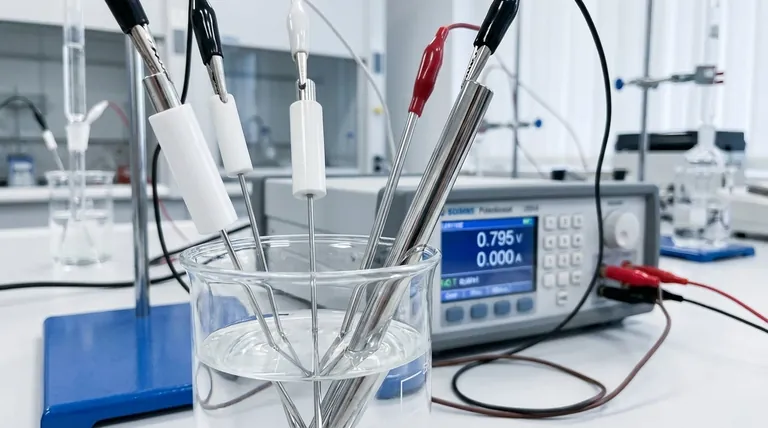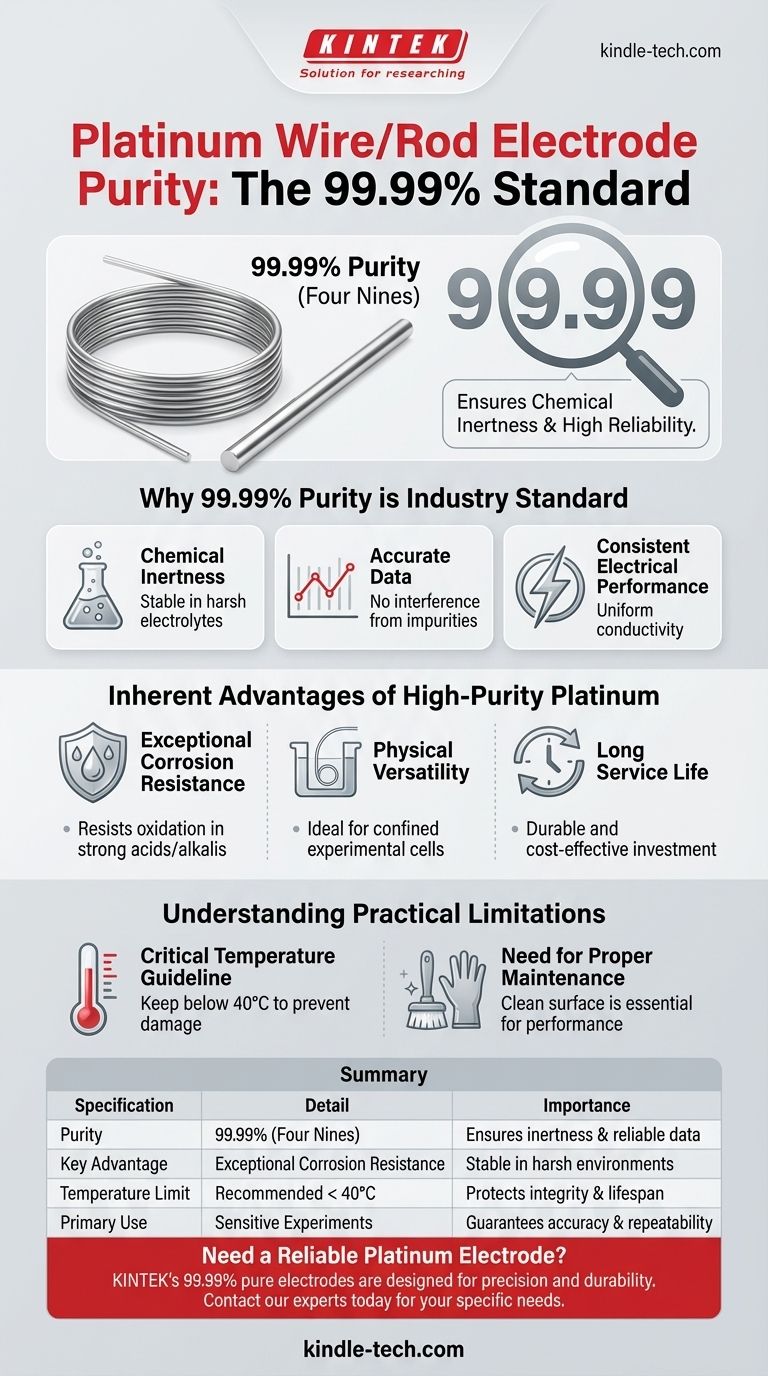The standard purity of a laboratory-grade platinum wire or rod electrode is 99.99%. This specific purity level, often referred to as "four nines," is not arbitrary; it is a critical specification that guarantees the electrode's chemical inertness and provides the high degree of reliability required for sensitive electrochemical experiments.
The core takeaway is that while the 99.99% purity ensures the platinum itself will not interfere with your experiment, the electrode's overall performance and lifespan are equally dependent on understanding and respecting its practical operational limits.

Why 99.99% Purity is the Industry Standard
The quality of an electrode is paramount in electrochemistry, where even trace contaminants can alter results. The 99.99% purity standard directly addresses this need by minimizing potential sources of error.
Ensuring Chemical Inertness
With impurities constituting less than 0.01% of the material, the electrode behaves as pure platinum. This makes it exceptionally stable and non-reactive, even when used in harsh electrolytes like strong acids and alkalis.
Guaranteeing Accurate Data
Impurities in a lesser-grade electrode could leach into the solution or react unexpectedly, creating electrical signals that interfere with your measurements. The 99.99% standard ensures that the experimental data you collect is accurate, repeatable, and reliable.
Providing Consistent Electrical Performance
Platinum is an excellent electrical conductor. High purity ensures this conductivity is uniform and predictable, allowing for efficient and consistent electron transfer, which is the primary function of an electrode.
The Inherent Advantages of High-Purity Platinum
Beyond purity, the fundamental properties of platinum make it an ideal material for electrodes used in a wide range of applications.
Exceptional Corrosion Resistance
Platinum is a precious metal known for its ability to resist corrosion and oxidation. This allows it to maintain its integrity and performance over long periods and across many different chemical environments.
Physical Versatility
The wire and rod forms are particularly useful for their flexibility. They can be easily integrated into small or confined experimental cells where larger plate electrodes would not fit, allowing for fine manipulation and precise placement.
Long Service Life
When used and maintained correctly, the stability and durability of high-purity platinum contribute to an extremely long operational lifespan, making it a cost-effective investment for a laboratory.
Understanding the Practical Limitations
Even a high-quality instrument has operational boundaries. Pushing an electrode beyond its design limits can compromise its performance, regardless of its material purity.
The Critical Temperature Guideline
While the metal platinum has a very high melting point and excellent heat resistance, the electrode as a device is often not designed for high-temperature work. It is generally recommended to keep the operating temperature below 40°C.
Excessively high temperatures can affect seals or other components of the electrode assembly, leading to performance degradation and a shortened lifespan.
The Need for Proper Maintenance
The electrode's surface must be kept clean and free from contamination or physical damage. Proper storage and cleaning protocols are essential to ensure the 99.99% pure surface remains active and effective for every experiment.
Making the Right Choice for Your Goal
Selecting and using an electrode correctly depends on understanding how its specifications align with your experimental needs.
- If your primary focus is high-precision analysis: The 99.99% purity is non-negotiable, as it is your best guarantee against measurement interference and experimental artifacts.
- If you are working with aggressive chemical solutions: The superior inertness of high-purity platinum provides the stability needed for accurate results in strong acids or bases.
- If your experiment requires controlled temperatures: Always adhere to the manufacturer's thermal limits (typically below 40°C) to protect the electrode's integrity and ensure its longevity.
Ultimately, leveraging both the material's intrinsic purity and the device's operational guidelines is the key to achieving accurate and repeatable results.
Summary Table:
| Specification | Detail | Importance |
|---|---|---|
| Purity | 99.99% (Four Nines) | Ensures chemical inertness and reliable data |
| Key Advantage | Exceptional corrosion resistance | Stable in acids, alkalis, and harsh environments |
| Temperature Limit | Recommended below 40°C | Protects electrode integrity and lifespan |
| Primary Use | Sensitive electrochemical experiments | Guarantees accuracy and repeatability |
Need a reliable platinum electrode for your lab?
KINTEK's 99.99% pure platinum wire and rod electrodes are designed for precision, durability, and consistent performance in even the most demanding electrochemical applications.
Contact our experts today to discuss your specific needs and ensure you get the right electrode for accurate, repeatable results.
Visual Guide

Related Products
- Platinum Sheet Electrode for Laboratory and Industrial Applications
- Rotating Platinum Disk Electrode for Electrochemical Applications
- Platinum Auxiliary Electrode for Laboratory Use
- Gold Disc Electrode
- Gold Electrochemical Sheet Electrode Gold Electrode
People Also Ask
- What is the proper post-treatment procedure for a platinum sheet electrode? Ensure Long-Term Accuracy & Protect Your Investment
- How should a platinum sheet electrode be operated during an experiment? Ensure Accurate and Reproducible Results
- How should a platinum sheet electrode be pretreated before use? Ensure Accurate Electrochemical Measurements
- What are the available specifications for platinum sheet electrodes? Find the Perfect Fit for Your Electrochemical Needs
- What is the expected lifespan of a platinum sheet electrode? Maximize Your Electrode's Service Life



















